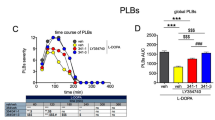Summary
The present study corroborates previous findings showing that the selective, non-competitive N-methyl-D-aspartate (NMDA) antagonist MK-801 [(+)-5-methyl-10,11-dihydroxy-5 H-dibenzo(a,d)-cyclohepten-5,10-imine] produces a dose-dependent increase in locomotion in mice pretreated with a combination of the monoamine-depleter reserpine and the catecholamine synthesis inhibitor α-methyl-para-tyrosine. Moreover, the present investigation demonstrates a synergistic interaction between MK-801 and the α-adrenergic agonist clonidine in monoamine-depleted mice: MK-803 in a dose of 1 mg/kg and clonidine in a dose of 2 mg/kg hardly affected locomotion when given separately, but when the two drugs were combined a dramatic enhancement of motor activity was observed. This effect was effectively antagonized by the α2-adrenergic blockers idazoxan and yohimbine, as well as by the “atypical” neuroleptic clozapine.
Likewise, a clear-cut synergism was observed when a low dose of the dopamine receptor agonist apomorphine (0.1 mg/kg), which did not per se affect motor activity, was combined with MK-801 (1.5 mg/kg); however, the synergism between apomorphine and MK-801 was less dramatic than that observed between MK-801 and clonidine.
The results may have important neuropsychiatric implications related to, e.g. the treatment of Parkinson's disease and the pathogenesis of schizophrenia.
Similar content being viewed by others
References
Carlsson A (1978) Antipsychotic drugs, neurotransmitters, and schizophrenia. Am J Psychiatry 135: 164–173
Carlsson A (1988) The current status of the dopamine hypothesis of schizophrenia. Neuropsychopharmacology 1: 179–186
Carlsson M, Carlsson A (1989) The NMDA antagonist MK-801 causes marked locomotor stimulation in monoamine-depleted mice. J Neural Transm 75: 221–226
Clineschmidt BV, Martin GE, Bunting PR, Papp NL (1982) Central sympathomimetic activity of (+)-5-methyl-10,11 -dihydro-5 H-dibenzo(a,d)cyclohepten-5,10-imine (MK-801), a substance with potent anticonvulsant, central sympathomimetic, and apparent anxiolytic properties. Drug Dev Res 2: 135–145
Johnson KM (1983) Phencyclidine: behavioral and biochemical evidence supporting a role for dopamine. Fed Proc 42: 2579–2583
Perry BD, Simon PR, U'Prichard DC (1983) Interactions of neuroleptic compounds at α2-adrenergic receptor affinity in bovine caudate nucleus. Eur J Pharmacol 95: 315–318
Ramirez OA, Wang RY (1986) Locus coeruleus norepinephrine-containing neurons: effects produced by acute and subchronic treatment with antipsychotic drugs and amphetamine. Brain Res 362: 165–170
Wong EHF, Kemp JA, Priestley T, Knight AR, Woodruff GN, Iversen LL (1986) The anticonvulsant MK-801 is a potent N-methyl-D-aspartate antagonist. Proc Natl Acad Sci USA 83: 7104–7108
Author information
Authors and Affiliations
Rights and permissions
About this article
Cite this article
Carlsson, M., Carlsson, A. Dramatic synergism between MK-801 and clonidine with respect to locomotor stimulatory effect in monoamine-depleted mice. J. Neural Transmission 77, 65–71 (1989). https://doi.org/10.1007/BF01255820
Received:
Accepted:
Issue Date:
DOI: https://doi.org/10.1007/BF01255820




